Nature Conservation 2023 — 5. 6. 2023 — Nature and Landscape Management — Print article in pdf
What Does the European Union´s Nature Restoration Law Mean for Nature Restoration in the Czech Repub
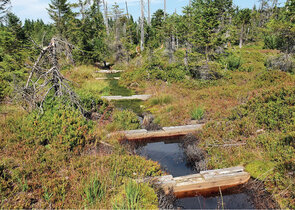
On 22 June 2022, the European Commission published a draft Nature Restoration Regulation of the European Parliament and the Council. It brings a legislative instrument to fulfil the EU Biodiversity Strategy 2030 adopted two years ago, which includes a plan for nature restoration and is one of the pillars of the European Green Deal. The European Commission thereby fulfils its task arising from the strategy, to submit a legally binding proposal for objectives in the field of nature restoration (restoration of disturbed ecosystems). The dramatic increase in extreme weather events, risks and threats in the area of living standards, security and social peace significantly increases the urgency of implementing measures aimed at restoring ecosystems, as a prerequisite for ensuring long-term food and energy self-sufficiency as well as human well-being.
The nature restoration plan included in the EU Biodiversity Strategy 2030 (hereinafter the EU Strategy) may appear ambitious and difficult to implement (PEŠOUT 2020); however, its immediate implementation is necessary for our continued survival (HERMOSO et al. 2022). We are fully dependent on intact nature – for food, in terms of the availability of clean water and air, and of course also for health. In many parts of the world, we can observe a dramatic decline in insects, including pollinators, without which three-quarters of food crops cannot be produced (IPBES 2019). The summary of scientific evidence included in 6th Assessment Report of the Intergovernmental Panel on Climate Change (IPCC), taking into account the interdependence of climate, ecosystems, biodiversity, and human society, is unequivocal: climate change directly threatens the human well-being and the health of the entire planet. With each additional delay in mitigating the climate change negative impacts and adapting to it, we miss a short and rapidly closing opportunity to secure a viable and sustainable future for all (IPCC 2022). A recent study completed as part of the evaluation of the EU Strategy 2020 (EC 2022) shows that the EU failed to halt the loss of biodiversity in 2011 - 2020. The outlook for biodiversity including ecosystems is bleak and shows that the current approach has not been working. Therefore, the European Parliament and the Council insist on intensifying efforts to restore ecosystems. In a resolution of January 2020 (EP 2020), the European Parliament called on the European Commission to move from voluntary commitments to the design of an ambitious and inclusive strategy that would establish legally binding (and therefore enforceable) quantified targets for the EU and its Member States.
Comprehensive standard
The draft Nature Restoration Regulation of the European Parliament and the Council – the Nature Restoration Law (hereinafter the Regulation) is built as a comprehensive standard following the existing EU legislation in nature conservation (Birds Directive, Habitats Directive, Regulation on Invasive Alien Species), as well as in protection of rivers and other water ecosystems (Water Framework Directive) and other EU documents (e.g. EU Forest Strategy until 2030 and EU Pollinator Initiative). The Regulation fulfils not only the European Green Deal, but also other European Union´s policies and concepts in sustainable management and use of natural resources. Its legislative point of view (i.e. the form, character, and structure) is presented in more detail by STEJSKAL (2022) in the previous issue of this journal.
The Regulation is not only focused on the restoration of ecological functions in natural habitats, as defined by the existing, above-mentioned legislation, but in the landscape as a whole, on broadly defined groups of ecosystems of agricultural landscapes, cities, forests, watercourses, and on habitats important for pollinators, etc. If we are to live up to the obligation of comprehensive nature restoration arising from the Regulation, it shall be necessary to abandon the existing isolated, sectoral approach, where conservation and management of Specially Protected Areas, watercourse administration, landscape management, management of the green infrastructure in urbanized areas, and land-use/territorial planning are dealt with separately.
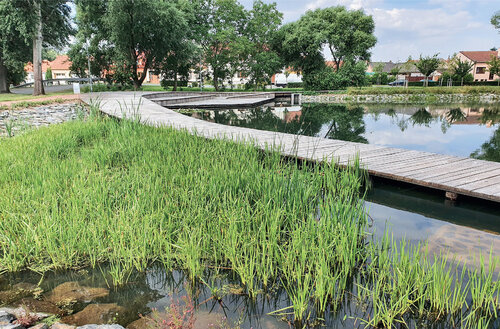
The Nature Restoration Regulation also focuses on urbanized areas aiming at increasing and enhancing public green spaces. With the help of national subsidy/subvention programmes and those with the participation of the EU, green and blue infrastructure has been built in human settlements for many years. Pictured is a project to improve rainwater management and restore a reservoir in the centre of the municipality of Bratčice (South Moravia). © Pavel Pešout
Amendment to the Act on Nature Conservation and Landscape Protection (?)
In connection with implementation of the Regulation in the Czech Republic, there are considerations about the need for a comprehensive amendment or even a new law on nature conservation and landscape protection. The Act on Nature Conservation and Landscape Protection is certainly outdated in some parts, for example in the special protection of species (PEŠOUT et al. 2022); however, thanks to its structure when it was adopted, we can still build on it and the necessary quick changes can be made by partial amendment. The fact that the draft Regulation is in the form of an actual regulation also testifies to the mentioned approach – it is a directly applicable EU regulation that is not further transposed and it is "only" necessary to ensure its connection with national legislation, i.e. so-called adaptation.
It will be necessary to determine the competences for implementation of the Regulation, in particular the responsibility for the preparation of the National Nature Restoration Programme (NNRP), which will be a very demanding process with extensive participation of stakeholders, municipalities, land managemers, and the general public. Furthermore, it will be necessary to anchor the responsibilities for reporting and data collection for the EU authorities. The necessity of legislative amendments in relation to the Regulation´s provisions concerning the right to NNRP´´ s judicial review in relation to a potentially large circle of authorized persons cannot be ruled out (to expand public participation, cf. STEJSKAL 2022).
A partial amendment will probably be required for general nature conservation, where it will be most appropriate to include substantive links and implementation details related to fulfilment of the Regulation. In particular, it will create the conditions for sufficient improvement in the quality and quantity of natural habitats for EU requirements, including their restoration and connection, while taking into account the ecological requirements of the species that are bound to these habitats. For this, it would be appropriate to use the existing establishment of Significant Landscape Elements (SLEs), especially those "by law", and specify the method for defining their individual segments (where it is not obvious), conservation objectives and management, etc. Another tool, which should be the basis for fulfilling the requirement to ensure landscape connectivity, is the Territorial System of Ecological Stability (TSES), a national multilateral ecological network sensu stricto, or its modernized form (see below).
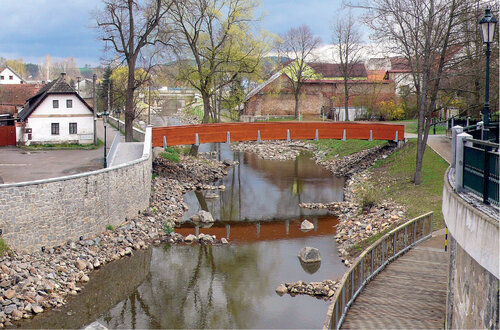
Restorations within a built-up area are being successfully implemented in an increasing number of municipalities in the Czech Republic. An example is the Blanice River, which has been restored along the entire length of its flow through the town of Vlašim (Central Bohemia). At the same time, all four local weirs were made permeable for biota on this section. © Pavel Pešout
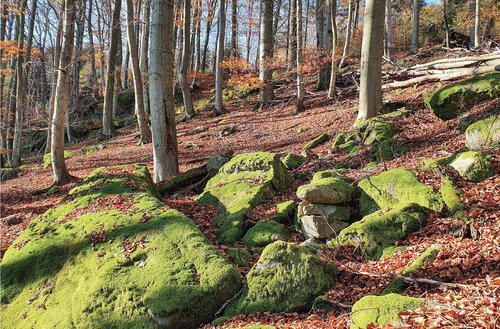
The commitment to protect nature on 30% of the country can also be fulfilled by including private reserves established by the Czech Union for Nature Conservation, Czech Society for Ornithology, and other associations, such as the Jehliště Primeval Forest near the town of Sedlec – Prčice (Central Bohemia). © Pavel Pešout
Adjustment of established general territorial protection, especially SLEs and TSES, in the legislative and methodological areas is also a prerequisite for fulfilling another obligation arising from the EU Strategy, namely to protect at least 30% of the EU's land area by 2030. At the EU level, this means increasing the protected land area by 4% compared to the present. In the case of the Czech Republic, the extent of all protected areas (after removing territorial overlaps) is 17,249.1 km2, i.e. 22.1% of the country´s territory. If we were to fulfil the objectives of the Strategy at an unreduced level, an additional 8% of the Czech Republic´s territory will need to be protected, i.e. approximately 6,310 km2. There is an opportunity to complete the network of large-size Specially Protected Areas, i.e. to declare the new Morava and Dyje/Thaya Rivers Confluence Protected Landscape Area, Krušné hory/Ore Mountains PLA, Doupovské hory PLA, Středomoravské Karpaty/Central Moravian Carpathians Mts. PLA, and Rychlebské hory/Rychleby Mts. PLA (PEŠOUT 2015, PEŠOUT & DORT 2022), but even this will not be sufficient, and including at least selected TSES and SLE components is necessary (KNÍŽÁTKOVÁ & HAVEL 2022 – see pages 14 - 19 in this issue).
Changes to regulations in the area of landscape design and use (?)
The Regulation comprehensively addresses the overall state of the landscape. The majority of measures are therefore not aimed at Specially Protected Areas, but rather at cultivated and inhabited landscape without distinction. Settings, competences, and opportunities for current nature conservation are not enough to preserve biodiversity; they alone cannot ensure that nature fully returns to our lives. It is precisely "bringing nature back into our lives" that is the main motto of the EU Strategy, and the ecosystem restoration plan, which the Regulation is supposed to help to fulfil, is one of the main tools. Let us remind ourselves that the Regulation brings binding goals in restoration of disturbed and damaged ecosystems. Among the most essential is ensuring an improvement in at least a third of the species and natural habitats protected by the relevant EU legislation which are not currently in a favourable condition. It is obvious that without an overall improvement in the state of the agricultural landscape/farmland, forests and water ecosystems, without a change in approaches in land-use/territorial planning, we will not be able to achieve this goal, as well as others related to, for example, the state of pollinators.
In the case of freshwater ecosystems, the Commission notes only slow implementation of the Water Framework Directive and formulates a key commitment – to restore at least 25,000 km of negatively affected watercourses to free-flowing rivers by 2030. This is to be achieved by removing or modifying obstacles that prevent fish migration and the natural movement of sediments, primarily those that are not used for energy production, inland navigation, water supply, etc. The Czech Republic has significant issues in this area. Although there is a concept of making the river network passable/permeable, it has only been fulfilled in a fragmentary way (VOGL 2019). The sub-basin plans include dozens of proposals for measures, yet the morphological status and continuity of the watercourses is slowly being restored, despite a favourably financial support. In order to change the status more quickly, it will be necessary to ensure greater motivation of watercourse managers. In this context, an extension of the main subject of state basin enterprise activities in the Basin Act is proposed. In the Water Act, it would be appropriate to make partial changes simplifying the discussion and preparation of restoration buildings, changes enabling the restoration of watercourses to be used on a large scale, and dealing with water abstraction for fish crossings at hydropower facilities (KUJANOVÁ 2022).
The Regulation also focuses on forests. The objective is to increase the species diversity, age and spatial structure of forests with the aim of increasing their quality and resilience, strengthening their biological diversity and carbon storage capacity, while taking into account their production function. In addition to changes in forest management (e.g. preference for non-age-class forestry, improvement of the quality of natural habitats of EU importance), partial changes to forestry legislation will probably be necessary, especially to enable monitoring the prescribed set of indicators, e.g. introduction of an indicator in forestry planning for monitoring the volume of standing and lying dead wood (HOFMEISTER & SVOBODA 2022 - see pages 20 - 23 in this issue). Within the obligations arising from the Regulation, it will also be necessary to look at the currently ongoing preparation of legislation changes in hunting because the current overpopulation of ungulates, namely cloven-hoofed game, significantly limits the forest ecosystem restoration.
Furthermore, it will probably be necessary to amend legislation in construction and land-use/territorial planning, e.g. to ensure the fulfilment of an increase in urban green spaces (by 3% by 2040 and 5% by 2050 compared to 2021), or an increase in green spaces that are incorporated into existing and new buildings and infrastructure, including their renovation and restoration.
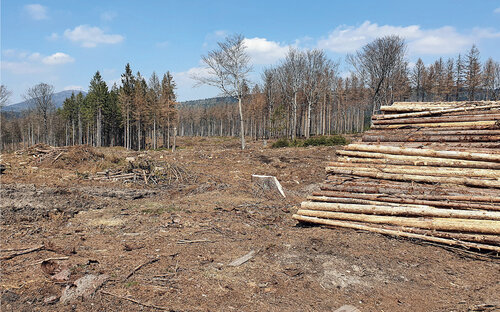
Damage to spruce monocultures by the European spruce bark beetle outbreak is an opportunity to change the forest management method and to restore species- and age-varied stands – pictured the Lužické hory/Lusatia Mts. Protected Landscape Area (northern Bohemia). © Pavel Pešout
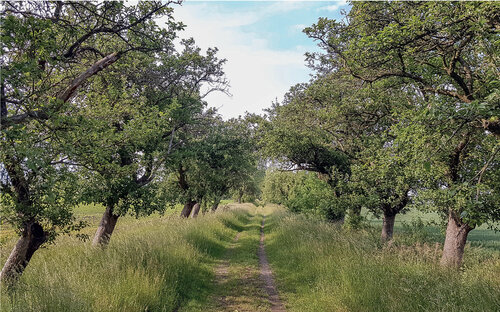
The Regulation emphasizes green infrastructure and connectivity. There should be an increase in the representation of landscape elements on agricultural land – pictured an avenue of fruit trees in the Polabská nížina/Labe/Elbe River Lowland between municipalities of Velim and Sokolčí (Central Bohemia). © Pavel Pešout
Completion of green infrastructure
In the urban environment, the Regulation focuses on increasing green spaces (especially the proportion of trees, but also greenery as part of buildings and infrastructure), which also fully corresponds to one of the points of the Government's current programme statement We will advocate improving the climate in cities and municipalities with their significant greening. We will legislatively anchor so-called blue-green infrastructure. Overall, the Regulation can be understood, with its emphasis on strengthening the connectivity of habitats, forests, free-flowing rivers and ensuring the proportion of landscape elements in the agricultural landscape, as a significant impetus to support the green infrastructure of the landscape and the application of nature-based solutions, i.e. solutions based on natural processes.
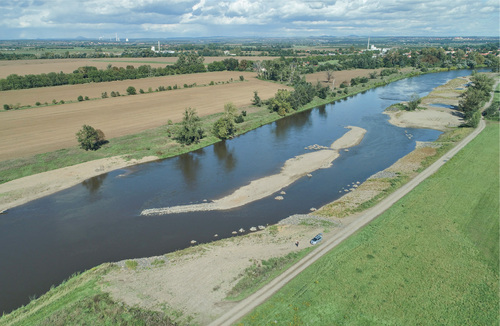
If the Czech Republic is to fulfil the goal of restoring the morphological state of 250-300 km of rivers by 2030, it will be necessary to ensure an increased allocation of funds in subvention programmes/subsidy schemes for this type of measure. Restoration of the 10 km long section of the Vltava River Vraňany – Hořín (Cenmtral Bohemia) implemented by Povodí Vltavy/Vltava River Basin Management Authority, State Enterprise thanks to the Operational Programme Environment´s support of EUR 7.6 million. © Povodí Vltavy/ Vltava River Basin Management Authority, State Enterprise archive
The backbone of green (and blue) infrastructure in the Czech Republic is an ecological network – a system of interconnected natural and semi-natural areas, where we evaluate and protect the level of resistance and resilience, and which we manage differently according to priorities. Its foundation is represented by the Territorial System of Ecological Stability (TSES) and the Specially Protected Area network, but also most of the Significant Landscape Elements (SLEs) and some nature parks. The segments of the ecological network today cover 56% of the Czech Republic (PEŠOUT & HOŠEK 2012). Functional superstructure consists of defined habitats of wild animals, including their movement corridors having been defined and provided for land-use/territorial planning since 2020 (PEŠOUT et al. 2018 a, 2018b). We can say that the Czech Republic has already had a sufficiently robust ecological network, but it is necessary to specify the definition of some segments, to start consistently applying existing legislative and economic tools for its conservation and management in broad cooperation with managers and municipalities. In addition, in the case of TSES, a fundamental paradigm shift is needed. It is necessary to further consider the conservation, restoration, and connection of current natural habitats and their characteristic species (HLAVÁČ & PEŠOUT 2017).
National Nature Restoration Programme (NNRP)
The pillar of the Regulation is the processing of NPOP. Many goals, tasks and measures resulting from the Regulation have already been part of existing national policies, concepts and strategies, most of them approved by the government after inter-ministerial discussions (Strategic Framework of the Czech Republic 2030, National Plan for Adaptation to Climate Change, National Biodiversity Strategy, State Nature Conservation Programme, Concept for Protection against the Consequences of drought, National Forestry Programme, river basin plans, etc.) and, as already indicated above, many of the Regulation goals also resonate with the Government's current programme statement. Links and complementarities will need to be established, especially in measures fulfilling existing legislation, such as the priority action framework for the EU Natura 2000 network. NPOP will more specifically quantify and prioritize both territorial and qualitative commitments in the field of nature restoration, taking into account national specifics. Coordination of NNTP with the RePower EU initiative is also required, particularly with the delineation of zones suitable for the installation of renewable energy sources. The new legislative framework will also need to be considered when updating the National Biodiversity Strategy, which awaits us in 2025 (and possibly the State Nature Conservation Programme, if it still exists); considering the ambitions of the Regulation and NNRP, its fundamental revision will be necessary.
Changes in setting support
According to the position of the Czech Republic on the draft Regulation discussed in the Parliament of the Czech Republic (HAVEL et al. 2022), to fulfil its goals it will be necessary to ensure adequate financial support, or adaptation of both EU and national financial mechanisms. Within their national budgets, the Member States (including the Czech Republic) will have to take into account the need to direct expenses towards goals in nature restoration, conservation, and support for increasing biological diversity. However, the goals of the support are not entirely new, they result from the existing legal framework of EU legislation in nature conservation and from national policies, concepts, and strategies in biodiversity, landscape, and climate change impact management.
The subvention programmes/subsidy schemes within the Ministry of the Environment of the Czech Republic is set up in an appropriate way for the implementation of restoration measures. It includes support for small non-investment measures (primarily the Landscape Management Programme), smaller investments (primarily the Landscape Natural Function Restoration Programme, currently strengthened from the National Recovery Plan and Project Scheme of the National Conservation Agency of the Czech Republic financed by the Operational Programme Environment (OPE)), as well as larger investment activities (OPE). It is certain, however, that without significant financial support from the OPE and the Ministry of the Environment of the Czech Republic national programmes, the Czech Republic will not be able to fulfil the Regulation goals by 2030. For example, we should restore the good condition of at least 30% of the coverage of natural habitats or significantly accelerate (at least five times compared to OPE 2014-2020) the improvement of the morphological status of watercourses (including the removal or opening of migration/movement barriers) and the natural functions of related floodplains. The underfunding of OPE will be partly improved by the currently discussed reallocation from the Integrated Regional Operational Programme (IROP), but it is certain that it is only a partial solution and further changes in the setting of the programmes will have to be adopted, while as the time for their fulfilment progresses, this will represent an increasingly difficult task.
For the strengthening of blue and green infrastructure in cities and the planning public green spaces, significant support is set, especially in the IROP, to a lesser extent also within the OPE and the National Recovery Plan.
Agriculture is of absolutely fundamental importance for the state of biological diversity, including the landscape. The basic tool for implementing and monitoring the implementation of the Regulation as well as the goals of the Farm to Fork Strategy (EC 2020b) is the new Common Agricultural Policy (hereinafter the CAP). The currently finalized setting of the CAP in the Czech Republic has managed to move more in the desired direction compared to previous periods (ČÁMSKÁ 2018), yet when watching the protests of some large farmers, one cannot avoid the feeling that the premise on which the European Commission was based when formulating the Strategy and Regulation was not understood: Farmers are among the first to feel the effects of biodiversity loss and are also among the first to reap the benefits of its conservation and restoration, as biodiversity helps them secure safe, sustainable and affordable food and provides them with income.
Supplementing the monitoring system
The Regulation establishes the scope of mandatory long-term monitoring of the state of biodiversity and inventories and reporting to the European Commission. This is partly already implemented monitoring (e.g. Common Bird Index, habitat mapping), but in a number of other cases, these are indices on the state of biodiversity and the landscape that have not yet been anchored (e.g. the dead wood volume left in forests, the abundance and diversity in pollinators, canopy stratification of greenery in cities, etc.).
In addition to what follows from the Regulation, the key commitment of the EU Strategy is also ensuring effective management of all protected areas, defining clear conservation goals, and monitoring of their fulfilment. The ongoing integrated project of the EU LIFE Programme One Nature of the Ministry of the Environment, NCA CR and academic institutions, together with the NCA CR project entitled Information System for Nature Conservation II" should contribute significantly to achieving this goal in Specially Protected Areas (ZÁRYBNICKÝ et al. 2020). However, in general nature conservation, the Landscape Register module will need to be completed in connection to the Regulation within the Nature Conservancy Information System (NCIS). It is a long-planned project, which, however, has not yet been fully implemented, and so far only a few parts have been developed (e.g. Memorial/Veteran Tree Database, TSES in Protected Landscape Areas). The Landscape Register will be necessary to monitor the fulfilment of obligations in general territorial nature conservation (area coverage and management provisions/measures).
The regulation is subject to amendments
The draft Regulation is currently being discussed by the relevant group within the Council of the EU (Working Party on the Environment) – currently led by the Presidency of the Czech Republic in the Council of the European Union (CZ PRES) – and simultaneously in the European Parliament. Within all EU Member States, national parliaments have also been at various stages of discussion on and negotiations of the position towards the proposal. The Czech position was discussed between ministries and presented to the Parliament of the Czech Republic in July 2022 (HAVEL et. al. 2022). The Committee for European Affairs of the Chamber of Deputies approved the proposed position of the Czech Republic on 5 October 2022 (Committee Resolution No. 96), and so did the Senate on 12 October 2022 (Senate Resolution No. 578).
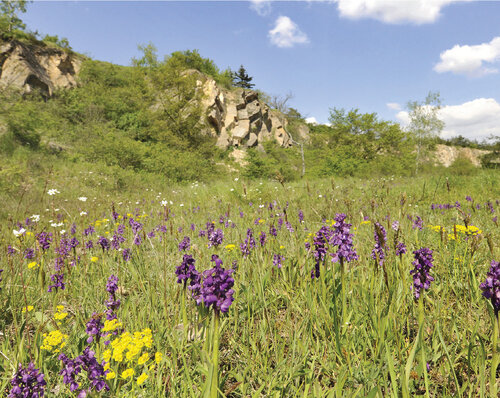
Quarry after renaturalization. © Zdeněk Patzelt
It can be assumed that, based on the progress and conclusions of negotiations at all levels, the text of the Regulation will be modified. The main part of the discussion in the European Parliament (draft report, amendments, voting) will probably take place in the first half of 2023, when Sweden will follow up on the CZ PRES in discussions within the EU Council and there will be discussions on revisions of the text, etc. The next phase, i.e. a trialogue and the overall finalization of the process can be expected in the second half of 2023 at the earliest.
With regard to the Czech Republic´ s current role as a Member State country holding the Presidency, when (especially in this initial phase) the main role is primarily to chair the discussion on the legislative proposal, the upcoming period and negotiations on the proposal will be crucial. It will be important for the Czech Republic to apply its priorities (as formulated in the Position of the Czech Republic) and at the same time "be there" so that we have sufficient insight into the principles stipulated in the Regulation and are able to fulfil it. If the Regulation is passed at the end of 2023 (with effect from 2024), we will have to work hard on the preparation of the necessary legislative steps and above all the Regulation implementation, preparation of NPOP, etc. The result should be more resilient ecosystems and a healthy landscape for us and our descendants.

